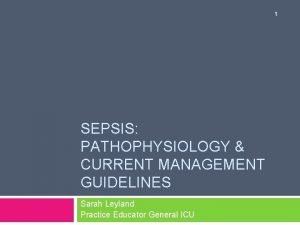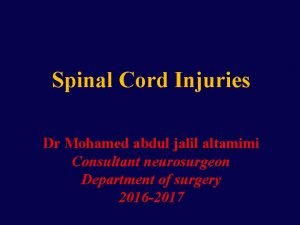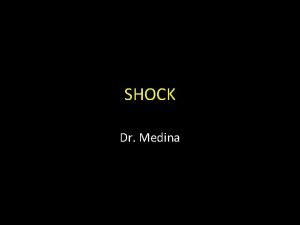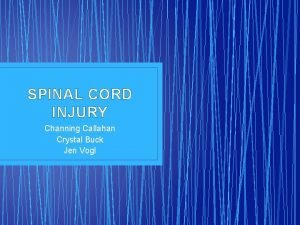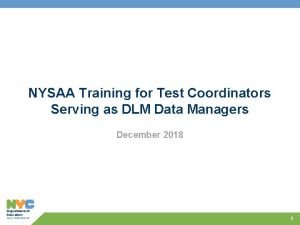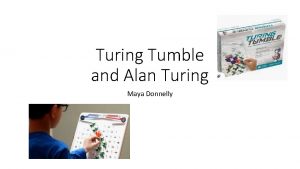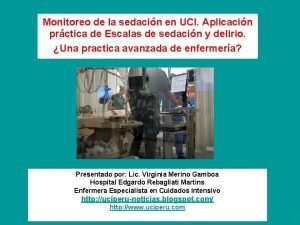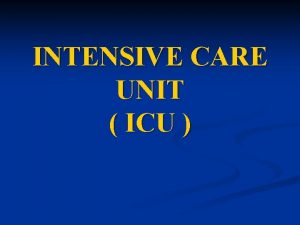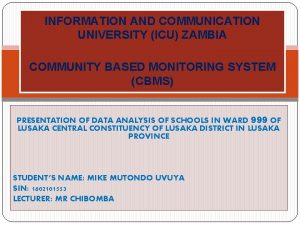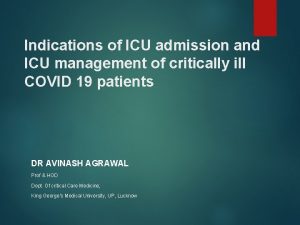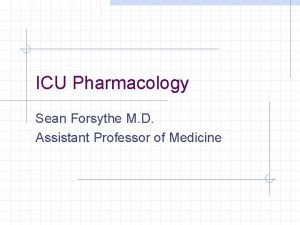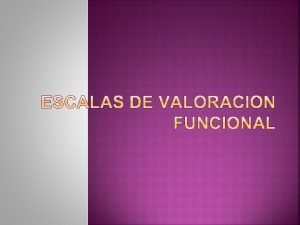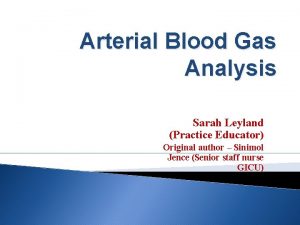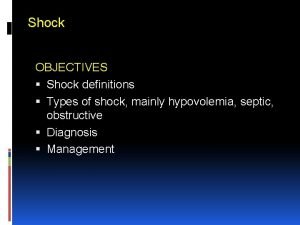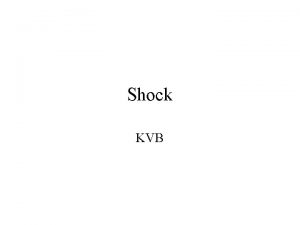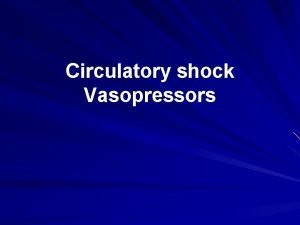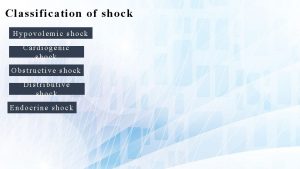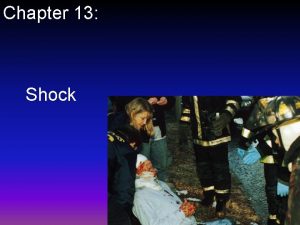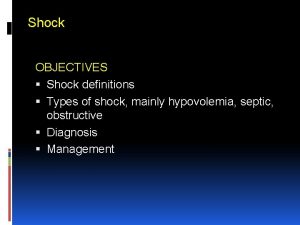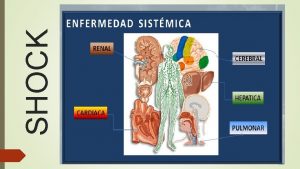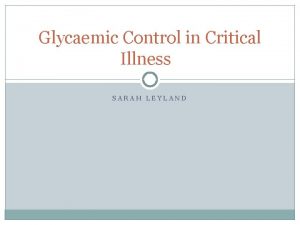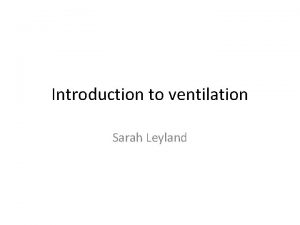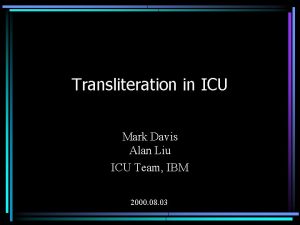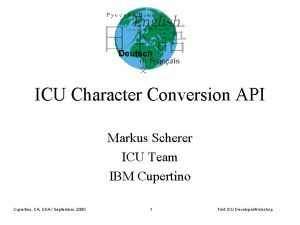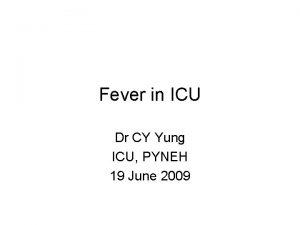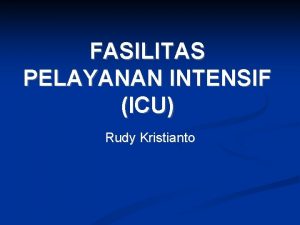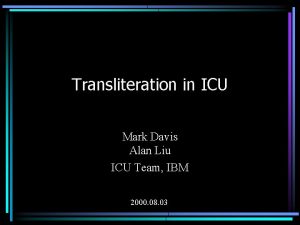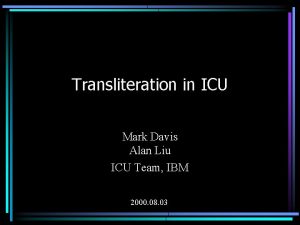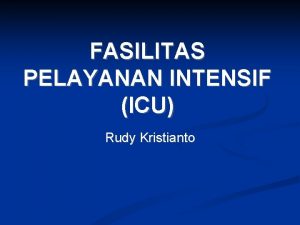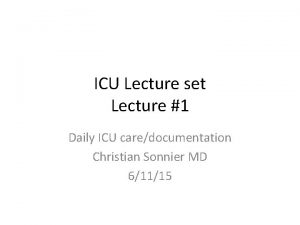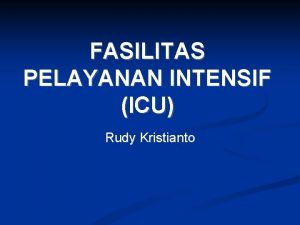Shock Sarah Leyland Practice Educator General ICU 1





































- Slides: 37

Shock Sarah Leyland Practice Educator – General ICU 1

Learning Outcomes Review shock at a cellular level Discuss categories of shock Describe clinical features of the different types of shock Identify management strategies for shock 2

Shock Shock is “circulatory insufficiency” Often goes unrecognised in its early stages Shock is never the primary diagnosis Reflects the bodies attempts to preserve vital functions 3

Shock definition “Failure to deliver and / or utilise adequate amounts of oxygen leading to tissue dysoxia” Antonelli et al (2007) Intensive care medicine 33, 575 -590 n. b definition does not include hypotension (but this is usually present). If hypotension absent markers include Scv. O 2, Sv. O 2, base deficit, lactate, perfusion related low p. H 4

Shock at a cellular level Hypoxaemia or perfusion failure result in anaerobic metabolism =2 ATP molecules, (aerobic=36 ATP molecule) Na-K pumps fail, ( K, Na and water enter cell) (Darovic 2002) 5

ESCIM (2014) 6

Capillary function Swollen cells reduce capillary lumen diameter, reducing blood flow Clumping of blood cells plugs capillaries Cell junctions between cells widen allowing leaking Unstable cellular environment > lysosomes release (Darovic 2002) 7

Organ systems Depending on number of cells lost organ damage may occur Persons response to shock depends on preexisting disease, drug use, age, magnitude if illness and time period of development of shock (Darovic 2002) 8

Stage 1 –Compensated (Initial) A fall in BP is detected this causes the release of adrenaline and noradrenaline that increase heart rate, contractility and vasoconstrict blood vessels. BP may be normal, but heart rate is increased, urine output decreased, patient may be cool to touch and restless 9

Stage 2 – Decompensated (Progessive) BP falls, cerebral and myocardial hypoperfusion result in deteriorating mental status, myocardial ischaemia and absent peripheral pulses Stress response causes vasoconstriction waxy, pale, cold, clammy skin. Pale mucous membranes and nail beds, low UO 10

Stage 3 – Irreversible (Refractory) All major organ systems are affected Systemic hypoperfusion will ultimately become incompatible with life (Darovic 2002) 11

“Double Edged Sword” of compensation in shock Darovic (1995 p. 448) Systemic vasoconstriction maintains blood flow to vital organs Inflammatory mediator release facilitates phagocytosis and resolution of injury But: Less essential circulations sacrifices: massive tissue ischaemia and lactic acidosis Prolonged or overwhelming mediator release leads to SIRS and multiple organ failure. 12

What is blood pressure made of? CO (= HR x SV) SVR Contractility

Categories: 1. 2. 3. Cardiogenic shock Hypovolaemic shock Distributive shock : - Septic shock - Neurogenic shock - Anaphylactic shock. More than one type of shock can exist in an individual. 14

Cardiogenic Shock The most common cause is MI What is the spiral of events that follows a drop in blood pressure? 15

Hypovolaemic shock This is a reduction in the circulating volume leading to decreased venous return and cardiac output 16

Sepsis: Pathophysiology related to mediator and neuro endocrine repsonse: Maldistribution of circulating blood volume Imbalance of oxygen supply and demand Alterations of metabolism 17

Definitions – Changed in 2016 et al (2016) Seymour (2016) Singer et al Sepsis – “life threatening organ dysfunction caused by disregulated host response to infection” (Singer et al 2016) Organ dysfunction = change in SOFA score (Seymour et al 2016) Septic Shock = subset of sepsis in which profound circulatory, cellular and metabolic abnormalities are assoc. with a greater risk of mortality than sepsis alone (Singer et al 2016) 18

Anaphylactic shock An exaggerated systemic allergic reaction to an antigen The antigen-antibody or substances such as contrast media cause release of mediator substances. This causes ‘leaky capillaries’ and generalised swelling and acute pulmonary oedema. Arteries dilate causing hypotension Smooth muscle contraction cause bronchospasm 19

Neurogenic Shock May be produced by spinal cord damage or pharmacological blockade at T 6 or above Brain stem messages to the peripheral nerves to maintain vasoconstriction and cardioaccelerator reflexes are interrupted. This may cause hypotension and bradycardia 20

ESCIM (2014) Three ‘windows’ through which to view signs of hypoperfusion: Ø Peripheral – skin that is cold, clammy and blue , pale or discoloured Ø Renal - urine output < 0. 5 ml/kg/hour Ø Neurologic – obtundation, confusion Ø Low BP may not be present 21

Patient Assessment Consciousness level / Mentation reports of pain Blood pressure Heart rate / Pulses Respiratory system Cutaneous Urine output Invasive haemodynamic monitoring – needs to be PAC if severe, need dynamic assessment of fluid status 22

General Principles of Treatment Correct the primary cause. Ensure adequate airway, ventilation, and arterial oxygenation Fluid resuscitation ? (Probably crystalloids) Followed by vasoactive drugs ESCIM (2014) – targets for BP initially Map> 65 mm. Hg……. But alterations if haemorrhage and also for sepsis in known hypertensive patient 23

ESCIM (2014) 24

Starling Curve

Most important inotrope? Fluid! Fluid challenge should be given over 5 -10 mins Assessment before and after to see where you are on Starling curve If SV rises 10% or more you are on the up slope and more fluid can be given to good effect If you give inotropes or vasopressors to an under-filled patient, side effects and mortality worsen

Inotropes and Vasopressors Correct terminology seldom used Vasopressor – causing vasoconstriction Inotrope – increasing contractility Chronotrope – increasing heart rate Inodilator – inotrope and vasodilator

Commonly seen in ICU Noradrenaline – vasopressor Vasopressin – vasopressor (consultant direction only G ICU) Dobutamine – inodilator Milrinone – inodilator Dopamine – inotrope (& vasopressor) Dopexamine – mild inotrope and selective (gut & mesentery) dilator Adrenaline – inotrope, vasopressor and chronotrope

Hypovolaemia - management Hypovolaemia – aim is to stop fluid loss and restore blood volume - fluid challenges. Note massive haemorrhage protocol (new Nov 2015) Ensure adequate ventilation and oxygenation. N. B care required with opiates (inhibit arteriolar constriction) 29

Cardiogenic shock Cardiogenic shock – systolic BP< 90 mm. Hg for at least 30 mins, CI <2. 2 l/min/m 2, PAOP >15 mm. Hg Investigations – ECG, Bloods (inc. novel trial device) Interventions include: Thrombolysis, angiography, PCI, CABG may be required for re perfusion Analgesia – Morphine < sympathetic response and < diaphoresis Control rhythm disturbances Pharmocological adjustment to SVR 30

31

Neurogenic shock - management Continuous ECG monitoring Atropine may be required if Heart rate <50 and systolic BP<80. This type of shock MUST be distinguished from hypovolaemia Aggressive fluid therapy may precipitate pulmonary oedema in neurogenic shock. Vasopressors may also be required. Careful monitoring is needed – signs of abdominal trauma may be missed due to flaccid abdominal wall in tetraplegic patients. (Adam and Osborne 2005) 32

Singer et al (2016) 33

Singer et al (2016) 34

Surviving sepsis campaign (2016) www. survivingsepsis. org 35

‘Survive Sepsis’ UK initiative – education programme The Sepsis Six ◦ ◦ ◦ High flow oxygen Take blood cultures Give IV antibiotics Start IV fluid resuscitation Check lactate Monitor hourly urine output All to be completed within 1 hour of suspected sepsis diagnosis 36

What next? Revision References: of sepsis bundles 2016 S & Osborne S (2005) Critical Care Nursing; science and practice (2 nd Ed). Oxford: Oxford Medical Publications. Cecconi et al (2014) Consensus on circulatory shock and haemodynamic monitoring. Task force of the European Society of Intensive Care Medicine. Int Care Med. 40 1795 -1815 Darovic G (2002) Haemodynamic Monitoring: invasive and noninvasive clinical application. Saunders. Philadelphia Dellinger et al (2012) International guidelines for the management of severe sepsis and septic shock Int Care Med. www. resus. org. uk anaphylaxis algorithm Seymour et al (2016)Assessment of clinical criteria for sepsis For the Third International Consensus Definitions for Sepsis and Septic Shock (Sepsis -3). JAMA 315 (8) p. 762 -774 Singer et al (2016) The third International Consensus Definitions for sepsis and Septic Shock (Sepsis -3) JAMA 315(8) p. 801 -810 Adam 37
 Sarah leyland
Sarah leyland Bryan leyland
Bryan leyland Ashok leyland low floor bus
Ashok leyland low floor bus Cauda equina vs conus medullaris
Cauda equina vs conus medullaris Normovolemico
Normovolemico Spinal shock vs neurogenic shock
Spinal shock vs neurogenic shock Spinal shock symptoms
Spinal shock symptoms Subacute combined degeneration of the cord
Subacute combined degeneration of the cord Student.kiteaai
Student.kiteaai Micro teach lesson plans
Micro teach lesson plans Remunerative conduct examples
Remunerative conduct examples Georgia professional standards commission
Georgia professional standards commission Msde educator portal
Msde educator portal Nurse educator resume
Nurse educator resume Microsoft teacher academy
Microsoft teacher academy Define health education
Define health education Hbsp for educators
Hbsp for educators Allied educator primary school
Allied educator primary school Alabama educator code of ethics
Alabama educator code of ethics Slo and ppg examples
Slo and ppg examples Turing tumble simulator
Turing tumble simulator Nevada educator performance framework
Nevada educator performance framework Ga ethics exam
Ga ethics exam Tspc sanction list
Tspc sanction list Vumc educator portfolio
Vumc educator portfolio Office of educator services
Office of educator services Nc educator effectiveness system
Nc educator effectiveness system Bureau of educator certification florida
Bureau of educator certification florida Ct teacher certification reciprocity
Ct teacher certification reciprocity Comclassroom
Comclassroom Rumus perhitungan tenaga perawat rawat jalan
Rumus perhitungan tenaga perawat rawat jalan Escala sas
Escala sas Icu localization
Icu localization Icu tersier adalah
Icu tersier adalah Information and communication university zambia location
Information and communication university zambia location 5hs and 5ts
5hs and 5ts Pressors icu
Pressors icu Escala de morse y braden
Escala de morse y braden
